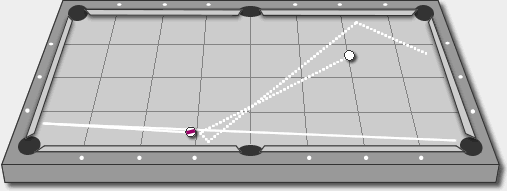 Shoot the object ball straight-back into the corner
while bringing the cueball back to the end rail. Shoot this shot
with enough speed so that object ball will go back to the other
end of the table if it misses the pocket.
Shoot the object ball straight-back into the corner
while bringing the cueball back to the end rail. Shoot this shot
with enough speed so that object ball will go back to the other
end of the table if it misses the pocket.
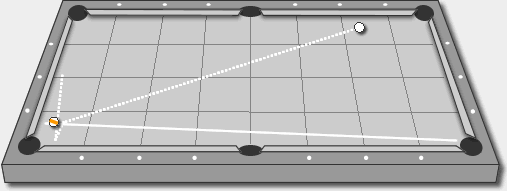 Another tough straight-back where the most important
goal is keeping the cueball near the end rail. Bryan Roberts
is my favorite for this shot.
Another tough straight-back where the most important
goal is keeping the cueball near the end rail. Bryan Roberts
is my favorite for this shot.
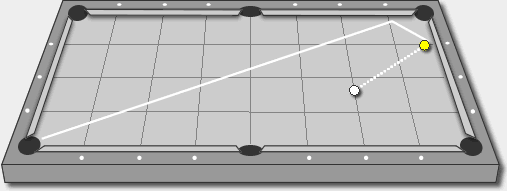 You've got nothing better to do here, so you may
as well try to make the object ball two rails in the corner.
Stop the cueball dead, and if the angle doesn't allow that, look
for something else. You want the object ball to just barely make
it to the pocket.
You've got nothing better to do here, so you may
as well try to make the object ball two rails in the corner.
Stop the cueball dead, and if the angle doesn't allow that, look
for something else. You want the object ball to just barely make
it to the pocket.
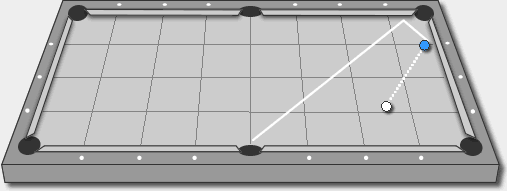 This is the same shot as above but with a slightly
flatter angle on the object ball. The only way to control the
cueball here is to try two rails in the side pocket. Shoot this
shot with just enough speed to make the object ball. It should
stop near the side pocket if it doesn't go in.
This is the same shot as above but with a slightly
flatter angle on the object ball. The only way to control the
cueball here is to try two rails in the side pocket. Shoot this
shot with just enough speed to make the object ball. It should
stop near the side pocket if it doesn't go in.
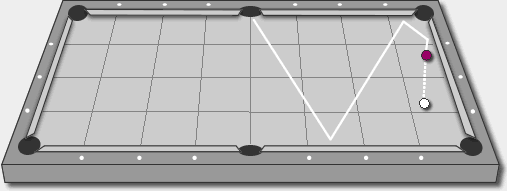 An even flatter variation on the last two shots.
You don't care about making the object ball nearly as much as
whether you can control the cueball or not. In this and the two
previous shots the angle between the cueball, object ball, and
the cushion dictates which is the best shot to take.
An even flatter variation on the last two shots.
You don't care about making the object ball nearly as much as
whether you can control the cueball or not. In this and the two
previous shots the angle between the cueball, object ball, and
the cushion dictates which is the best shot to take.
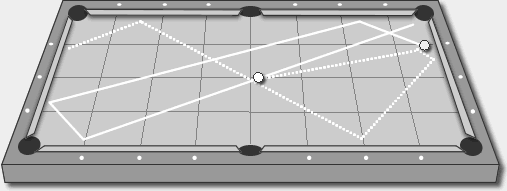 Note that this shot is not quite laying natural
for the four rail shot. This is a good thing, because it allows
you to send the cueball back up-table and keep it separated from
the object ball. If the shot was laying more natural, lending
itself to more of a stop shot, I'd pick something else before
risking leaving both balls at the same end of the table.
Note that this shot is not quite laying natural
for the four rail shot. This is a good thing, because it allows
you to send the cueball back up-table and keep it separated from
the object ball. If the shot was laying more natural, lending
itself to more of a stop shot, I'd pick something else before
risking leaving both balls at the same end of the table.
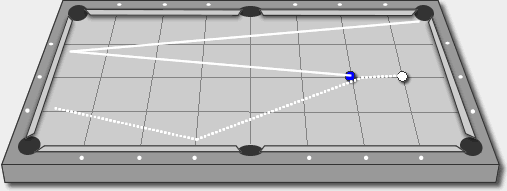 There are many ball positions where this type of
shot comes up. There are two goals here. First, you either (duh)
make the bank, or at least leave the object ball very close to
the pocket. Second, and maybe even more importantly, stick the
cueball as close to the far rail as you can.
Watch me shoot this shot (Windows
Movie 114KB) (Streaming High or Low Speed)
There are many ball positions where this type of
shot comes up. There are two goals here. First, you either (duh)
make the bank, or at least leave the object ball very close to
the pocket. Second, and maybe even more importantly, stick the
cueball as close to the far rail as you can.
Watch me shoot this shot (Windows
Movie 114KB) (Streaming High or Low Speed)
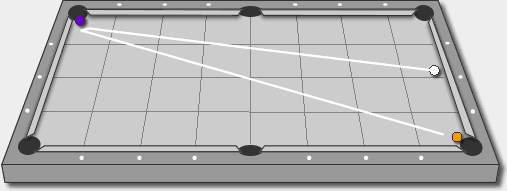 Not really a bank, but this still belongs in this
section. In this scenario, you need both balls and your opponent
needs one. When Candyman shot this at the 2003 Derby City Classic
instead of the more obvious pocket-the-five safety I thought
he'd made a mistake until he correctly pointed out that a good
opponent would never pocket the four in response. If you shot
the five first, you'd then need to take your next shot and pocket
the four. The way Candyman shot it gave him a chance to look
like a genius if both balls went in, and even if the five doesn't
go the spotted four is no gimme as long as the cueball speed
leaves it near the headrail.
Not really a bank, but this still belongs in this
section. In this scenario, you need both balls and your opponent
needs one. When Candyman shot this at the 2003 Derby City Classic
instead of the more obvious pocket-the-five safety I thought
he'd made a mistake until he correctly pointed out that a good
opponent would never pocket the four in response. If you shot
the five first, you'd then need to take your next shot and pocket
the four. The way Candyman shot it gave him a chance to look
like a genius if both balls went in, and even if the five doesn't
go the spotted four is no gimme as long as the cueball speed
leaves it near the headrail.
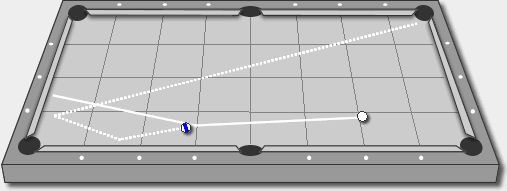 I won a game at the 2003 Derby City Classic with
this shot. This was the last ball on the table.
It's hard to tell from the diagram, but crossing the ball into
the
righthand
corner was not available because there was a kiss there. I shot
the ten with a bit of a jab that let the cueball drift to the
end rail while the ten went towards its target. The shot was
mostly intended to leave my opponent badly but the ten happened
to go in.
I won a game at the 2003 Derby City Classic with
this shot. This was the last ball on the table.
It's hard to tell from the diagram, but crossing the ball into
the
righthand
corner was not available because there was a kiss there. I shot
the ten with a bit of a jab that let the cueball drift to the
end rail while the ten went towards its target. The shot was
mostly intended to leave my opponent badly but the ten happened
to go in.
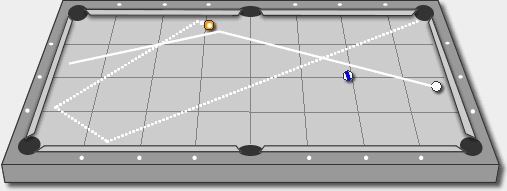 Another game winner from the Derby Classic. I needed
one ball, and my opponent had pocketed the ten and drawn back
to put me in a bind. There was nothing I could do with the ten
without a big chance of a scratch or a kiss, and I couldn't even
see all of the thirteen. I shot a little jump shot, playing mostly
to leave the cueball on the end rail, and the thirteen took the
route shown. That shot won me the match.
Another game winner from the Derby Classic. I needed
one ball, and my opponent had pocketed the ten and drawn back
to put me in a bind. There was nothing I could do with the ten
without a big chance of a scratch or a kiss, and I couldn't even
see all of the thirteen. I shot a little jump shot, playing mostly
to leave the cueball on the end rail, and the thirteen took the
route shown. That shot won me the match.
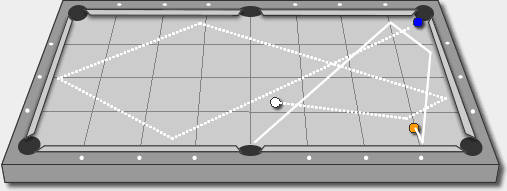 At the 2005 Derby City Classic, Larry Nevel had Truman Hogue two games to none. In this third game Larry needed both balls and Truman needed one. Larry saw nothing better and pulled off this masterpiece, then he banked the respotted 2-ball cross-side to win the game and the match. Opinions vary as to whether Larry's choice of shot was (a)reckless or (b)brilliant or (c)both.
At the 2005 Derby City Classic, Larry Nevel had Truman Hogue two games to none. In this third game Larry needed both balls and Truman needed one. Larry saw nothing better and pulled off this masterpiece, then he banked the respotted 2-ball cross-side to win the game and the match. Opinions vary as to whether Larry's choice of shot was (a)reckless or (b)brilliant or (c)both.





